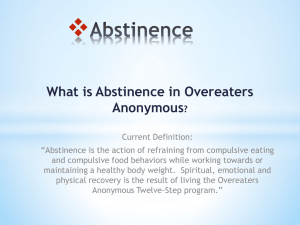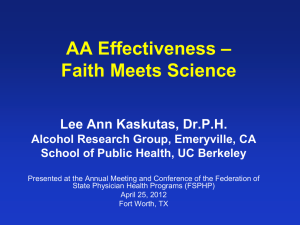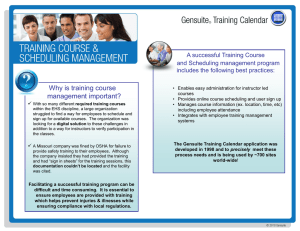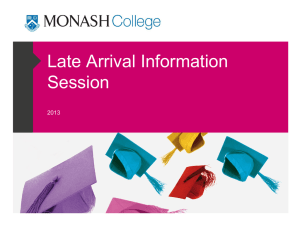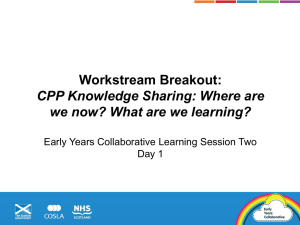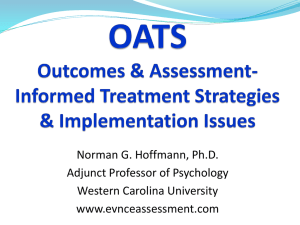Research Supports the use of the Twelve Steps - Marc J
advertisement
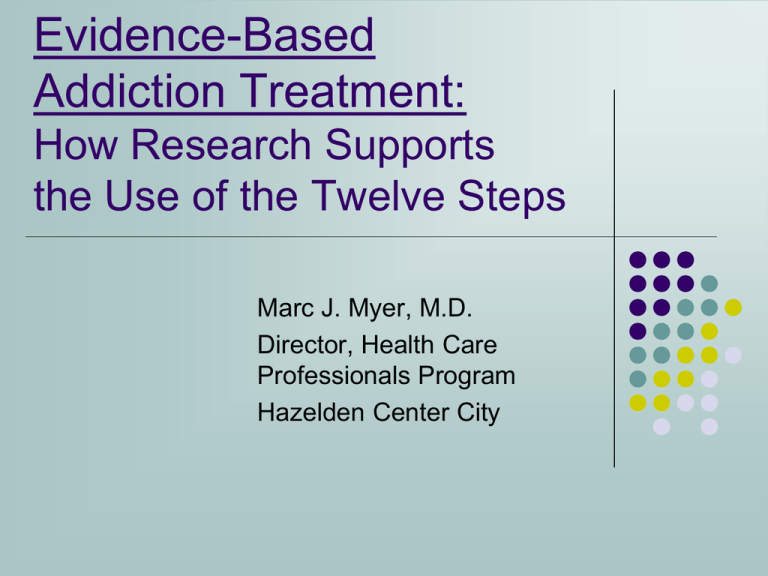
Evidence-Based Addiction Treatment: How Research Supports the Use of the Twelve Steps Marc J. Myer, M.D. Director, Health Care Professionals Program Hazelden Center City Why Examine AA? • ~30% lifetime prevalence of any alcohol disorder. NESARC 2001-02 • ~10% of those needing treatment actually receive it. NSDUH 2008 Why Examine AA? • In 2010, 4.1 million received help for substance abuse problem, 2.3 million using twelve step fellowships exclusively or along with treatment. NSDUH 2010 • More people use AA than any other resource to address problems with alcohol. McCrady & Miller 1993 Weisner, Greenfield, Room 1995 12 Step Programs Accessible Inclusive Adaptable/diverse Growing Inexpensive Successful Estimated AA Membership (January 2011) Members in U.S. Groups in U.S. 1,279,664 57,905 Members Worldwide Groups Worldwide 2,057,672 107,976 (AA is found in over 150 countries) www.aa.org (2013) “To alcohol! The cause of…and solution to…all of life’s problems…” Homer Simpson Who Attends AA? • No study has shown that there is more of one demographic group than any other in AA – true cross section. • Severity of alcohol-related problems is the strongest predictor of AA attendance. • Those with family and friends providing weak or inconsistent support for addressing alcohol problems are more likely to join AA. Who Attends AA? Gender has not been found to be a predictor of AA membership. Project MATCH showed no gender differences in rates or patterns of AA meeting attendance. AA data: 65% Male 35% Female In 1989, a Committee of the Institute of Medicine concluded: “Alcoholics Anonymous, one of the most widely used approaches to recovery in the United States, remains one of the least rigorously evaluated.” IOM 1989 A Review of the Early Research …”AA research has been mostly pre-experimental in design, has failed to use instrumentation of established reliability, has usually not attempted to check for the validity of the self report data obtained, has inadequately assessed the nature of subjects’ alcohol problems, has been deficient in describing demographic characteristics of the sample and has sampled an unrepresentatively large number of middle-aged people and an unrepresentatively small number of women.” Emrick, Tonigan, Montgomery, Little 1993 However… “Professionally treated patients who attend AA during or after treatment are more likely to improve in drinking behavior than are patients who do not attend AA, although the chances of drinking improvement are not overall a great deal higher.” Emrick, Tonigan, Montgomery, Little 1993 Another Review “From the perspective of experimental rigor, the quality of many AA studies was poor.” Tonigan, Toscova, Miller, J Stud Alcohol 1996 However… “Better designed studies report moderate and positive relationships between AA attendance and improved psychosocial functioning.” Tonigan, Toscova, Miller, J Stud Alcohol 1996 Cochrane Review “There is no conclusive evidence to show that AA can help patients to achieve abstinence, nor is there any conclusive evidence to show that it cannot.” “People considering attending AA or TSF programmes should be made aware that there is a lack of experimental evidence on the effectiveness of such programmes.” Ferri, Amato, Davoli, CDSR 2006 However… The Cochrane conclusion was heavily weighted on the study by Diana Chapman Walsh randomizing individuals to hospital inpatient treatment, AA meetings, or “choice”. Randomizing to AA 40 35 30 25 20 % abstinent at 2 yrs 15 10 5 0 Hospital inpatient AA meetings Alcohol abusers that were EAP referred n=227: n=73 hospital, n=83 AA, n=71 choice Choice Walsh et al., NEJM 1991 Why is AA difficult to study? • • • • Anonymous organization Steeped in tradition Singleness of purpose in AA Bias that “I know this works and no studies are needed” • Difficult/impossible to randomize individuals to one treatment vs. the other contamination • Difficult/impossible to determine which aspects of AA are critical and which are not Why is AA difficult to study? • Critics of AA and 12-step research: • AA is a cult that relies on God as a mechanism of action • Individuals self-select to AA • More motivated alcoholics attend AA which leads to better outcomes • Those with less severe psychopathology go to AA Research About AA: 2 Types • AA as a mutual help organization that supports abstinence • AA philosophy as a treatment modality (Twelve Step Facilitation Therapy) – Project MATCH 12-Step Facilitation Therapy Goals Acceptance Surrender Principles and objectives are: Behavioral Emotional Cognitive Spiritual Social Nowinski and Baker 2003 How do we establish causation? 1. 2. 3. 4. 5. 6. Strength of association Dose-response relationship Consistency Temporally correct Specificity Coherence with existing knowledge Adapted from Epidemiology: an introductory text Kaskutas, J Addictive Diseases 2009 Establishing causation 1. 2. 3. 4. 5. 6. Strength of association Dose-response relationship Consistency Temporally correct Specificity Coherence with existing knowledge 1. Strength of association 3,018 male veterans at 1 year follow up; AA/NA attendance from months 9-12 was associated with: More abstinence Freedom from substance use problems Freedom from significant distress and psychiatric symptoms More employment Ouimette et al., J Stud Alcohol 1998 Summary “Overall, 12 Step attendance and involvement were more strongly related to positive outcomes than was outpatient treatment attendance.” “The overall finding was that patients who participated in both outpatient treatment and 12 Step groups combined fared the best on 1 year substance use and psychosocial outcomes.” Ouimette et al., J Stud Alcohol 1998 1. Strength of association One and three-year abstinence rates among those attending formal treatment One and three-year abstinence rates among those attending formal treatment alone and those alone and those attending formal plus AA attending formal treatment plustreatment AA % abstinent 60 Formal treatment 50 Formal treatment + AA 40 * * 30 20 10 0 One-year follow-up Three-year follow-up * p < .05. Source: Timko et al., JSA 2000 Establishing causation 1. 2. 3. 4. 5. 6. Strength of association Dose-response relationship Consistency Temporally correct Specificity Coherence with existing knowledge 2. Dose-response relationship During treatment (Tonigan, Treatment Matching in Alcoholism 2003) ---Number of meetings during treatment predicts attending AA/NA/CA after treatment 3+ per week After treatment ---More meetings, more abstention (Moos et al., J Clin Psychol 2001) ---Weekly attendance predicts abstinence (Fiorentine, Am J Drug Alc Abuse 1999; also see Hoffman et al, IJA 1983; Toumbourou, JSAT 2002; Gossop et al, Alc&Alc 2003; Bottlender, Fort.derNeur.Psych 2005; for adolescents, see Alford et al, JSA 1991: 2yrs, 84% abstinent if weekly) Never in past 6 mos. 30% abstinent at 2 years Less than weekly 40% abstinent Weekly 75% abstinent Kaskutas 2007 2. Dose-response relationship Frequency of Meetings AA meetings Year 1 Abstinence Year 1 Year 8 No AA 21% 35% 2-4 mtgs/week 43% 57% 5+ mtgs/week 61% 73% Moos & Moos, J Consult Clin Psychol 2004 2. Dose-response relationship Duration of meetings Duration of AA meeting attendance Year 1 Years 2-8 % Abstinent, 8 yrs none 35 1-16 wks. 43 17-32 wks. 56 33+ wks. 71 none 48 1-12 mos. 33 13-48 mos. 64 49+ mos. 89 Moos & Moos, J Clin Psychol 2006 2. Dose-response relationship Of those followed up at 8 years (#395) it was found that the number of AA meetings attended during the first 3 years was positively related to: Remission from alcohol problems Lower levels of depression Higher quality relationships Compared with professionally delivered inpatient or outpatient treatment, “AA probably helped more people more substantially in this sample.” Humphreys, Moos, Cohen 1997 The frequency of AA attendance above a certain threshold and involvement in AA activities are clearly related to drinking outcomes. Establishing causation 1. 2. 3. 4. 5. 6. Strength of association Dose-response relationship Consistency Temporally correct Specificity Coherence with existing knowledge Naturalistic Studies: Consistent Evidence of 3. Consistency Abstinent AA Effectiveness 70% Nothing 60% Outpatient only AA only 50% AA + outpatient 40% 30% 20% 10% 0% 1-Year 3-Year aVA 8-Year inpatients (Ouimette et al., JSA 1998) bProblem Drinkers (Timko et al., JSA 2000) Establishing causation 1. 2. 3. 4. 5. 6. Strength of association Dose-response relationship Consistency Temporally correct Specificity Coherence with existing knowledge Project MATCH The first scientifically rigorous demonstration of the effectiveness of Twelve Step Facilitation, which is based on the 12 Steps, but remarkably different than attending a 12 Step program and working the Steps. Project MATCH 952 outpatients at 5 sites 774 aftercare patients at 5 sites (had completed residential treatment or intensive day treatment) The largest psychotherapy trial in history. Used 3 methods of treatment Cognitive Behavioral Therapy (CBT) Motivational Enhancement Therapy (MET) Twelve Step Facilitation (TSF) Project MATCH Study Design: 98% 97% 95% 94% 92% 85% 86% CBT MET TSF Screen Randomize FU3 6 9 12 15 (39) (120) Two Arms: Aftercare Sample N = 774, Outpatient Sample = 952 Tonigan 2004 4. Temporally correct Project MATCH showed that the frequency of AA meeting attendance as well as overall AA involvement in months 1-6 significantly predicted the percentage of days of alcohol abstinence during months 7-12 5. Specificity Project MATCH: Posttreatment & Three-Year Drinking Outcomes Longitudinal, RCT of 12-step vs other tx. Approach Outpatient arm, abstinent for 3 months prior to: 1-yr follow-up (p=.0024) 3-yr follow-up (p<.007) TSF 36% 36% CBT 25% 24% MET 30% 27% PMRG, JSA 1997 PMRG, ACER 1998 5. Specificity Selection bias? Baseline 1 year 2 years positive Motivation negative AA involvement negative Alcohol problems no diff Psychopathology 2,319 male VA patients no diff McKellar et al., J Consult Clin Psychol 2003 Project MATCH Determined Three Conclusions About Client Matching 1. 2. 3. For those drinkers whose social system is supportive of ongoing alcohol use, facilitating participation in AA (TSF) resulted in better outcomes than use of MET or CBT. Angry alcohol dependent clients have better outcomes using MET. Inpatients with high dependence on alcohol appear to do better with TSF group oriented aftercare than CBT. Project MATCH Research Group 1998 Establishing causation 1. 2. 3. 4. 5. 6. Strength of association Dose-response relationship Consistency Temporally correct Specificity Coherence with existing knowledge 6. Coherence with existing knowledge Why does AA work? What are the mediators that support positive outcomes? Mechanisms of Efficacy Self Efficacy – the confidence to reduce and stop drinking In Project MATCH, AA participation predicted self efficacy which predicted percentage of days abstinent in the 7-12 month period after treatment. Connors, Tonigan, Miller 2001 This was also shown at 3 year follow up. Owen, Slaymaker, Tonigan, McCrady, Epstein, Kaskutas, Humphreys, Miller 2003 Mechanisms of Efficacy Increased Social Support Involvement in self help groups predicted reduced substance use at 1 year follow up. “Both enhanced friendship networks and active coping responses appeared to mediate these effects.” Humphreys, Mankowski, Moos, Finney 1999 Follow up of men and women found “AA involvement and the type of support received from AA members were consistent contributors to abstinence 3 years following a treatment episode.” Bond, Kaskutas, Weisner 2003 Mechanisms of Efficacy Improved Coping Skills Proximal outcomes (1 and 6 month) were predicted by increased active coping efforts. Morgenstern, Labourie, McCrady, Kahler, Frey 1997 Active coping responses resulting from AA participation predicted reduction in substance use at 1 year follow up. Humphreys, Mankowski, Moos, Finney 1999 Multiple studies have examined 12 Step Affiliation vs Involvement General outcome: Attendance at 12 Step meetings is not likely to be as helpful as becoming actively involved in the 12 Step community. Which Activities Matter Most? Summarizing across 16 studies Strongest evidence for: • having a sponsor • being more involved in AA than in the past Next-strongest evidence is for: • leading an AA meeting • doing 12-step work Weaker relationships for: • sponsoring others • working last 7 steps Kaskutas 2007 National Practice Guidelines Support AA Participation Based on This Research ASAM: Public Policy Statement – Self Help Groups and Professional Treatment Department of Veteran Affairs: Clinical Practice Guidelines for Substance Use Disorder SAMHSA/CSAT: Treatment Improvement Protocols NIAAA: Helping Patients Who Drink Too Much Summary AA research has improved and expanded. Most of your clients with alcohol or drug problems will use 12 Step programs. Regular participation in 12 Step groups, especially during and after professional treatment, promotes abstinence and improved psychosocial functioning. Active involvement over long periods is beneficial. Self efficacy, increased social support and improved coping skills are related to AA attendance and positively correlated to abstinence. TSF works well for severe alcohol dependence and those with little social support for abstinence, while MET is better for angry alcohol dependent clients. Clinician Guidelines We need to prepare clients for 12 Step program participation and refer them to 12 Step groups. Learn the 12 Steps and principles associated with 12 Step recovery Learn the language and culture of 12 Step programs Learn about Twelve Step Facilitation Therapy Distinguish religion from spirituality Address myths associated with 12 Step groups Help clients find appropriate 12 Step groups Encourage active membership and attendance at least three times a week (evidence supports AA frequency) Encourage long-term attendance (evidence supports AA duration)
